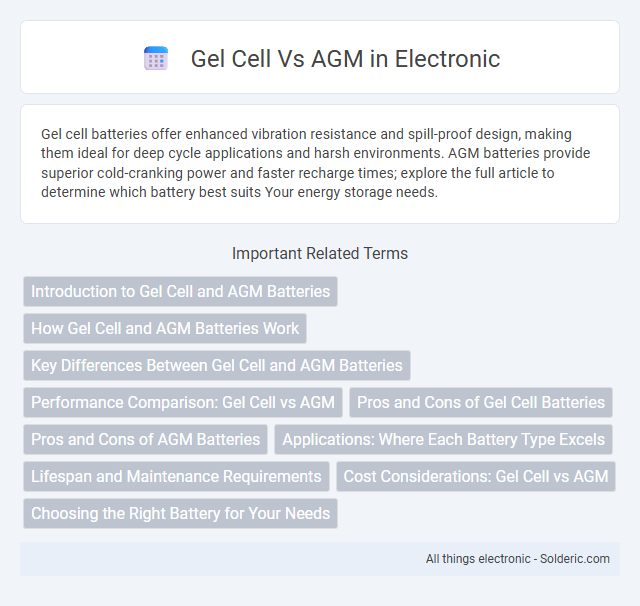Gel cell batteries offer enhanced vibration resistance and spill-proof design, making them ideal for deep cycle applications and harsh environments. AGM batteries provide superior cold-cranking power and faster recharge times; explore the full article to determine which battery best suits Your energy storage needs.
Comparison Table
| Feature | Gel Cell Battery | AGM Battery |
|---|---|---|
| Electrolyte Type | Silica-based gel electrolyte | Absorbed Glass Mat (fiber glass separator) |
| Maintenance | Maintenance-free | Maintenance-free |
| Durability | Good vibration resistance, suitable for deep cycles | High vibration resistance, excellent for high current outputs |
| Charging Attributes | Requires controlled charging to prevent damage | More tolerant of varying charge rates |
| Applications | Renewable energy, golf carts, wheelchairs | Automotive, UPS, motorcycles, power sports |
| Cost | Generally higher cost due to gel technology | Generally lower cost and widely available |
| Performance | Better performance in deep-cycle usage | Better suited for high power bursts and starting engines |
Introduction to Gel Cell and AGM Batteries
Gel cell and AGM batteries represent advanced sealed lead-acid technologies designed for deep cycle and standby power applications. Gel cell batteries use a silica-based gel electrolyte that provides excellent resistance to vibration, deep discharge, and extreme temperatures, making them ideal for off-grid solar systems and medical devices. AGM batteries, or Absorbent Glass Mat batteries, absorb the electrolyte in fiberglass mats, offering faster recharge times, lower internal resistance, and superior performance in high-current applications, perfect for automotive and UPS systems.
How Gel Cell and AGM Batteries Work
Gel cell batteries use a silica-based gel electrolyte that immobilizes the acid, preventing leaks and allowing deep discharge without damage, making them ideal for stability and longevity in harsh conditions. AGM (Absorbent Glass Mat) batteries feature a fiberglass mat that absorbs the electrolyte, enabling rapid charging, low internal resistance, and superior vibration resistance, suitable for high-performance applications. Your choice depends on whether you need enhanced durability in extreme environments (Gel cell) or faster energy delivery with maintenance-free operation (AGM).
Key Differences Between Gel Cell and AGM Batteries
Gel cell batteries use a silica-based gel electrolyte to immobilize the acid, offering superior resistance to vibration and deep discharges, making them ideal for off-grid solar systems and marine applications. AGM (Absorbent Glass Mat) batteries utilize fiberglass mats to absorb electrolyte, providing lower internal resistance, faster recharge times, and better high-current delivery suited for automotive and UPS systems. Key differences include gel cells' improved thermal stability and longer cycle life, while AGM batteries excel in lower cost, maintenance-free operation, and enhanced cold-weather performance.
Performance Comparison: Gel Cell vs AGM
Gel cell batteries offer superior resistance to deep discharge and excel in high-temperature environments, making them ideal for applications requiring consistent performance under stress. AGM (Absorbent Glass Mat) batteries provide lower internal resistance and faster recharge rates, which translates to better efficiency and power delivery for vehicles or devices with frequent start-stop cycles. Understanding the performance differences between Gel cell and AGM batteries helps you choose the optimal option based on your energy needs and operating conditions.
Pros and Cons of Gel Cell Batteries
Gel cell batteries offer superior resistance to vibration and extreme temperatures, making them ideal for off-grid solar systems and deep-cycle applications. Their maintenance-free design reduces the risk of acid leakage and extends lifespan compared to AGM batteries, though they have slower recharge rates and higher initial costs. Your choice depends on prioritizing durability and safety over quick charging and upfront affordability.
Pros and Cons of AGM Batteries
AGM batteries provide superior resistance to vibration and are maintenance-free, making them ideal for off-grid solar systems and vehicles. Their low internal resistance allows for faster charging and high discharge rates, yet they tend to have a shorter lifespan compared to gel cell batteries when exposed to deep discharges. AGM batteries also perform well in cold temperatures but can be more expensive upfront and sensitive to overcharging, which may reduce their cycle life.
Applications: Where Each Battery Type Excels
Gel batteries excel in deep cycle applications such as solar energy systems, marine use, and off-grid power storage due to their superior vibration resistance and low maintenance requirements. AGM batteries, with their high current output and faster recharge capabilities, are ideal for automotive starting, backup power supplies, and heavy-duty UPS systems. Both technologies offer sealed, spill-proof designs, but selecting between gel and AGM depends on specific energy demands and operational environments.
Lifespan and Maintenance Requirements
Gel cell batteries typically offer a lifespan of 3 to 5 years, requiring minimal maintenance due to their sealed, non-spillable design and resistance to vibration. AGM (Absorbent Glass Mat) batteries generally last around 4 to 7 years, also benefiting from a sealed construction but often needing periodic charging to prevent sulfation and maintain optimal performance. Both battery types are low-maintenance compared to traditional flooded batteries, with AGM leading slightly in longevity and gel cells excelling in durability under harsh conditions.
Cost Considerations: Gel Cell vs AGM
Gel cell batteries generally have a higher upfront cost compared to AGM batteries due to their complex manufacturing process and enhanced durability. AGM batteries offer a more budget-friendly option with competitive performance, making them popular for cost-conscious users seeking reliable power storage. Long-term maintenance and replacement expenses for gel cells may offset initial savings seen with AGMs, influencing overall cost efficiency.
Choosing the Right Battery for Your Needs
Gel cell batteries offer superior resistance to vibration and deep discharge, making them ideal for marine and off-grid renewable energy systems, while AGM batteries provide faster charging and lower internal resistance, suited for automotive and UPS applications. Selecting the right battery depends on factors such as desired cycle life, maintenance needs, operating temperature range, and budget constraints. Evaluating specific use cases and environmental conditions ensures optimal performance and longevity between Gel cell and AGM battery technologies.
Gel cell vs AGM Infographic

 solderic.com
solderic.com